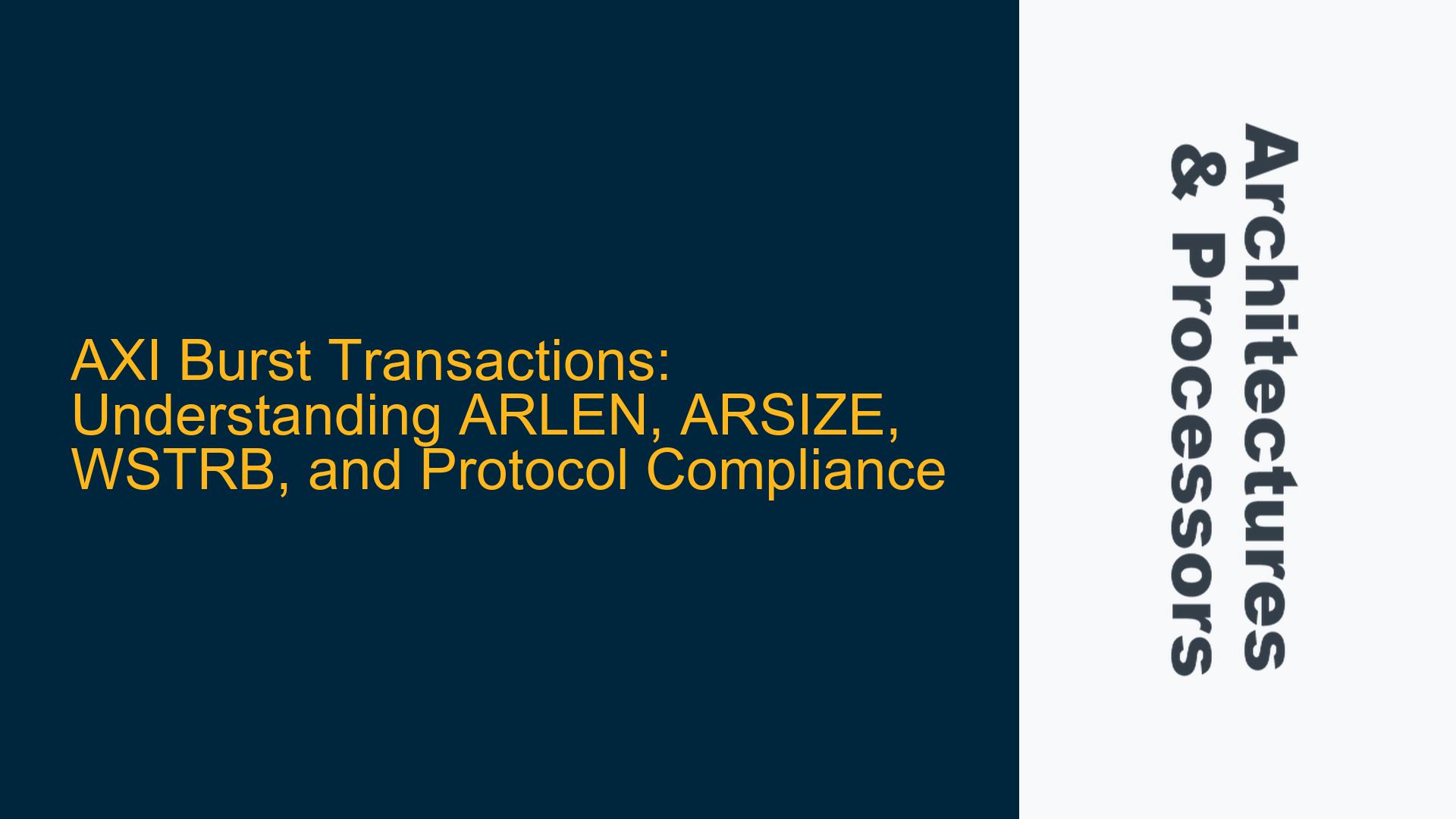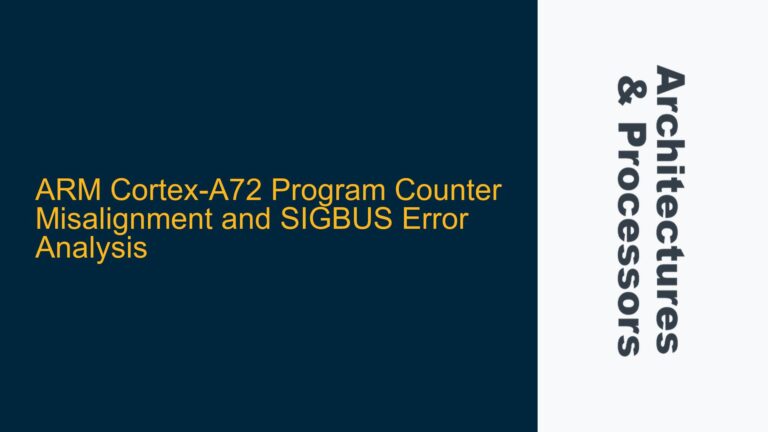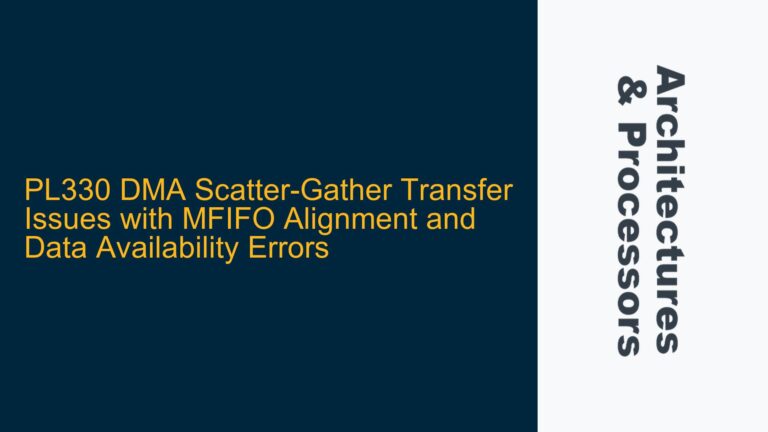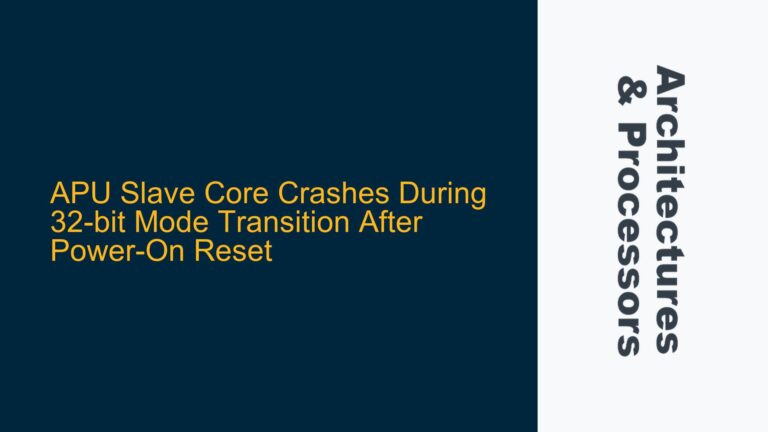AXI Burst Transaction Requirements and Response Handling
The Advanced eXtensible Interface (AXI) protocol is a critical component in modern System-on-Chip (SoC) designs, particularly when dealing with ARM-based architectures. AXI defines a high-performance, high-frequency interface between managers (initiators) and subordinates (targets). One of the most complex aspects of AXI is its handling of burst transactions, where multiple data transfers occur in a single transaction. A burst transaction is initiated with specific attributes, including ARLEN (burst length), ARSIZE (burst size), and in the case of write transactions, WSTRB (write strobe). These attributes define the expected behavior of the transaction, and any deviation from these expectations can lead to protocol violations or undefined system behavior.
In a read transaction, the manager initiates a burst request with ARLEN defining the number of transfers and ARSIZE defining the number of bytes per transfer. The subordinate must respond with data in the exact format specified by these attributes. For example, if ARLEN is set to 16 (indicating 16 transfers) and ARSIZE is set to 4 bytes (indicating 4 bytes per transfer), the subordinate must return 16 transfers of 4 bytes each, with the final transfer marked by RLAST. The Network-on-Chip (NoC) or interconnect is responsible for ensuring that the response adheres to the requested burst format, even if the transaction is split across multiple targets or involves AXI-lite targets that do not natively support burst transactions.
The AXI protocol does not allow the subordinate to return data in a format that deviates from the requested burst attributes. For instance, if the manager requests a 16-beat burst, the subordinate cannot return 16 separate single-beat transactions. The NoC must aggregate the responses and ensure that the data is returned in the exact burst format requested by the manager. This requirement ensures that the manager can process the data efficiently without needing to handle fragmented or misaligned responses.
Protocol Violations and Signal Mismatches in AXI Transactions
One of the most common sources of confusion in AXI transactions is the relationship between ARLEN, ARSIZE, and WSTRB, and how mismatches between these signals are handled. ARLEN and ARSIZE define the maximum number of bytes that can be transferred in a transaction, while WSTRB defines which specific bytes within that transaction are valid. For example, in a write transaction with AWLEN set to 16 (16 transfers) and AWSIZE set to 2 bytes (2 bytes per transfer), the manager can use WSTRB to indicate that only 1 byte per transfer is valid. This results in a total of 16 valid bytes being transferred, even though the transaction could have transferred up to 32 bytes.
A key point of contention is whether a mismatch between AWSIZE and WSTRB constitutes a protocol violation. For instance, if AWSIZE indicates 2 bytes per transfer but WSTRB enables all 4 bytes in a 32-bit bus, does this violate the protocol? According to the AXI specification, this is indeed a protocol violation. AWSIZE and AWLEN define the boundaries of the transaction, and WSTRB must only enable bytes within those boundaries. If WSTRB enables bytes outside the boundaries defined by AWSIZE and AWLEN, the transaction is considered invalid, and the resulting system behavior is undefined.
Similarly, the relationship between ARLEN and RLAST (or AWLEN and WLAST) must be strictly adhered to. ARLEN defines the number of transfers in a transaction, and RLAST must be asserted on the final transfer. If RLAST is asserted on a transfer that is not the final transfer as defined by ARLEN, this constitutes a protocol violation. The same applies to write transactions, where WLAST must be asserted on the final transfer as defined by AWLEN. These protocol violations must be detected during system verification simulations using protocol checker tools, as they can lead to undefined behavior in the final silicon implementation.
Implementing AXI-Compliant Burst Transactions and Debugging Common Issues
To ensure AXI-compliant burst transactions, designers must carefully manage the relationship between ARLEN, ARSIZE, and WSTRB, as well as the timing of RLAST and WLAST assertions. Below are some key considerations and troubleshooting steps for implementing and debugging AXI burst transactions:
1. Understanding Transaction Boundaries
- ARLEN and ARSIZE define the boundaries of a read transaction. ARLEN specifies the number of transfers, and ARSIZE specifies the number of bytes per transfer. The subordinate must return data within these boundaries, and the NoC must ensure that the response adheres to the requested burst format.
- For write transactions, AWLEN and AWSIZE define the maximum number of bytes that can be transferred, while WSTRB defines which bytes within those boundaries are valid. WSTRB must not enable bytes outside the boundaries defined by AWLEN and AWSIZE.
2. Handling Split Transactions and AXI-Lite Targets
- When a transaction is split across multiple targets or involves AXI-lite targets, the NoC is responsible for aggregating the responses and ensuring that the final response adheres to the requested burst format. This may involve buffering data and reordering responses to match the burst attributes specified by the manager.
- If the NoC fails to aggregate responses correctly, the manager may receive fragmented or misaligned data, leading to protocol violations or undefined behavior.
3. Debugging Protocol Violations
- Protocol violations often arise from mismatches between ARLEN and RLAST (or AWLEN and WLAST). These violations must be detected during system verification simulations using protocol checker tools.
- Common issues include RLAST being asserted on the wrong transfer or WSTRB enabling bytes outside the boundaries defined by AWSIZE and AWLEN. These issues can be debugged by tracing the transaction attributes and comparing them to the actual data transfers.
4. Optimizing AXI Transactions for Performance
- To optimize AXI transactions, designers should carefully balance burst length and size to minimize latency and maximize throughput. For example, using larger burst sizes (e.g., ARSIZE = 4 bytes) can reduce the number of transfers required for a given amount of data, but may increase latency if the subordinate cannot handle large bursts efficiently.
- Designers should also consider the capabilities of the NoC and subordinates when defining burst attributes. For example, if a subordinate cannot handle large bursts, the manager should use smaller burst sizes to avoid protocol violations or performance bottlenecks.
5. Ensuring Compliance with AXI Specifications
- Designers must ensure that all AXI transactions comply with the AXI specification, particularly with regard to ARLEN, ARSIZE, WSTRB, and RLAST/WLAST. This includes verifying that WSTRB only enables bytes within the boundaries defined by AWSIZE and AWLEN, and that RLAST/WLAST is asserted on the correct transfer.
- Protocol checker tools should be used extensively during system verification to detect and resolve any protocol violations before the final silicon implementation.
6. Handling Edge Cases and Extreme Scenarios
- Designers should test edge cases and extreme scenarios to ensure robust AXI transaction handling. For example, what happens if WSTRB enables all bytes in a transfer, even though AWSIZE indicates a smaller transfer size? According to the AXI specification, this is a protocol violation, and the system behavior is undefined.
- Similarly, designers should test scenarios where RLAST is asserted on the wrong transfer or where the NoC fails to aggregate responses correctly. These scenarios can be simulated using protocol checker tools to ensure that the system handles them gracefully.
7. Leveraging AXI Features for Efficient Data Transfer
- AXI provides several features that can be leveraged for efficient data transfer, including out-of-order transaction completion, multiple outstanding transactions, and write data interleaving. Designers should carefully consider these features when implementing AXI transactions to maximize performance and minimize latency.
- For example, out-of-order transaction completion allows the NoC to return data in the most efficient order, rather than strictly adhering to the order in which transactions were initiated. This can significantly improve performance in systems with multiple targets and complex data dependencies.
8. Debugging Tools and Techniques
- Debugging AXI transactions requires a combination of simulation tools, protocol checkers, and hardware debugging tools. Simulation tools can be used to trace transaction attributes and data transfers, while protocol checkers can detect violations of the AXI specification.
- Hardware debugging tools, such as logic analyzers and on-chip trace buffers, can be used to capture and analyze AXI transactions in real-time. These tools are particularly useful for debugging issues that only manifest in the final silicon implementation.
By following these guidelines and leveraging the features of the AXI protocol, designers can implement robust and efficient burst transactions that comply with the AXI specification and deliver optimal performance in ARM-based SoC designs.






